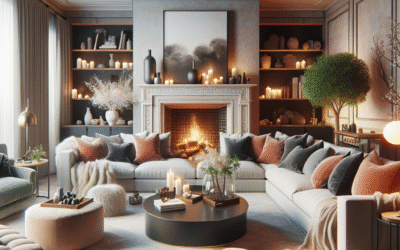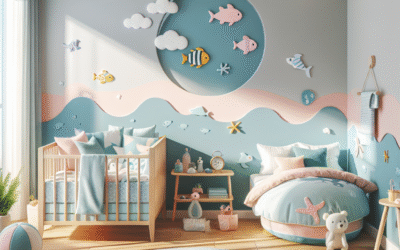
The Beauty of Scandinavian Design Inspiration for a Clean and Calm Home
In today’s fast-paced world, creating a living space that evokes serenity and simplicity feels more necessary than ever. The beauty of Scandinavian design inspiration for a clean and calm home lies in its ability to transform chaotic environments into peaceful sanctuaries. Rooted in minimalism, functionality, and natural elements, Scandinavian interiors offer timeless solutions for those seeking balance amidst modern life. Whether you’re redecorating your entire home or simply refreshing a room, embracing these principles means welcoming comfort, clarity, and style that never overwhelm.
Scandinavian design’s popularity continues to soar globally, and for good reason. It marries aesthetic appeal with purpose, emphasizing light, muted colors, and uncluttered spaces that promote relaxation and mental clarity. This comprehensive guide unpacks the key elements, practical tips, and inspiring ideas for implementing Scandinavian design in your home. You’ll also find curated product recommendations to help you source furniture and décor that embody the very essence of this style.
[dynamic_product_links_images_16_9 keyword=”The Beauty of Scandinavian Design Inspiration for a Clean and Calm Home” limit=”4″]
In the sections ahead, we’ll explore:
- The foundation of Scandinavian design philosophy and its origins
- Essential color palettes and materials that create clean, calm atmospheres
- Smart furniture choices that balance form with function
- Lighting strategies to amplify natural light and mood
- Decorative accents and greenery for subtle warmth and texture
- Practical organization ideas keeping clutter at bay while staying stylish
By the end, you’ll be equipped to reimagine your home as a calm retreat inspired by Scandinavian sensibilities, optimized both for comfort and contemporary living.
Understanding the Foundation of Scandinavian Design
The beauty of Scandinavian design inspiration for a clean and calm home begins with its origins in the Nordic countries—Denmark, Sweden, Norway, Finland, and Iceland. Emerging in the early 20th century, this design style was shaped by cultural values emphasizing simplicity, craftsmanship, and functionality.
The philosophy revolves around “less is more,” advocating for uncluttered, purposeful spaces that invite calm and increase practical living. It embraces natural light due to the long, dark winters in the region, and materials such as wood and wool that connect residents to nature. This sense of hygge — cozy contentment — integrates seamlessly with minimalist aesthetics to foster inviting yet efficient homes.
Key Characteristics Include:
- Neutral color schemes centered on whites, grays, and soft pastels
- Natural textures like birch, pine, leather, and linen
- Clean lines with minimal ornamentation
- Multi-functional furniture designed to optimize space
- Focus on sustainability and durability
Today, the enduring appeal of Scandinavian design is a testament to its thoughtful approach to living with intention and beauty.
Creating a Calm Color Palette for a Clean Home
Colors significantly influence mood and perception of space. Scandinavian design inspiration encourages muted, natural tones that promote calm and openness. Whites, soft grays, gentle blues, and earth tones work harmoniously to make rooms feel airy and uncluttered.
Popular Scandinavian Color Palette Choices:
| Color | Usage | Effect |
|---|---|---|
| Soft White | Walls, ceilings | Maximizes light, amplifies space |
| Muted Gray | Furniture, textiles | Adds subtle contrast, cozy neutrality |
| Light Wood Tones | Flooring, furnishings | Natural warmth, organic feel |
| Pale Blue or Soft Pastels | Accents, decor | Promotes tranquility |
When selecting colors for your home, consider the quality and direction of natural light for best effect. Cooler nuanced tones pair beautifully in sun-drenched rooms, while warmer pastels soften spaces with indirect sunlight.
Furniture That Balances Form and Function
Scandinavian design prioritizes furniture that blends simplicity with utility—clean silhouettes without sacrificing comfort or quality. Since many Scandinavian homes may face space constraints, pieces often are multifunctional and thoughtfully proportioned to preserve openness.
Typical Furniture Features:
- Natural materials: Light wood such as birch and ash
- Sleek shapes: Straight legs, tapered edges, minimal carving
- Multi-use designs: Nesting tables, extendable dining tables, storage ottomans
- Comfort fabrics: Natural linens, cotton blends, and wool upholstery
For example, the iconic Artek stools and chairs exemplify this ethos, pairing elegant form with resilient craftsmanship perfectly suited to clean and calm interiors.
[h2]Harnessing Natural and Artificial Lighting for Serenity[/h2]
Lighting directly impacts the atmosphere of any home, and Scandinavian design makes the most of every ray of natural daylight. Large windows, sheer curtains, and mirrors help bounce light around, countering the long dark periods typical in Nordic regions.
Alongside natural light, artificial lighting is selected with care to maintain warmth and softness. Pendant lamps, floor lamps, and wall sconces with simple Scandinavian designs contribute not just illumination but also sculptural interest without creating visual clutter.
Lighting Tips:
- Use layered lighting to mix ambient, task, and accent sources
- Opt for warm white LED bulbs to emulate natural daylight without harshness
- Install dimmers for adjustable mood settings
By integrating these lighting strategies, your home can achieve the clean and calm qualities distinct to this design style while maximizing comfort daily.
[h2]Accents, Textures, and Plants: The Finishing Touches[/h2]
While minimalism is central to the beauty of Scandinavian design inspiration for a clean and calm home, subtle accents and textures prevent spaces from feeling sterile. Natural textiles such as wool throws, cotton rugs, and linen cushions provide softness and tactile interest.
In addition, Scandinavian interiors frequently incorporate greenery, which adds life and vibrancy without overwhelming simplicity. Small potted plants, succulents, or even larger statement plants like fiddle leaf figs can harmonize beautifully within the design framework.
Decorative Accessories Ideas:
- Hand-thrown ceramic vases and bowls
- Minimalist wall art with geometric or nature-inspired patterns
- Cozy knitted throws and cushions in neutral hues
- Wooden trays and candle holders
These elements, carefully curated, punctuate purity with warmth and character, reinforcing the serene vibe.
[h2]Organization and Decluttering: Maintaining a Clean and Calm Space[/h2]
Essential to the Scandinavian aesthetic is maintaining order and avoiding clutter, which directly supports a calm home. Practical storage solutions that integrate seamlessly with furniture help keep belongings out of sight yet accessible.
Effective Tips:
- Use built-in shelving and hidden drawers
- Choose furniture with built-in storage compartments
- Implement regular decluttering sessions using the “keep, donate, recycle” approach
- Incorporate simple, elegant baskets and boxes for organizing smaller items
By combining stylish organization strategies, your home can stay inviting and calming without sacrificing everyday functionality.
[oasin_auto_seo_product_section_smart_links keyword=”The Beauty of Scandinavian Design Inspiration for a Clean and Calm Home” limit=”4″]
Frequently Asked Questions About The Beauty of Scandinavian Design Inspiration for a Clean and Calm Home
What defines Scandinavian design?
Scandinavian design is characterized by simplicity, functionality, and connection to nature. It features clean lines, neutral colors, natural materials, and a focus on creating calm, uncluttered living spaces.
How can I incorporate Scandinavian design on a budget?
Focus on decluttering, painting walls in light neutral tones, and investing in key natural-material pieces like wooden tables or textiles. DIY elements and secondhand Scandinavian-inspired furniture can also keep costs low.
What are the best materials to use in Scandinavian interiors?
Light woods such as pine, birch, and ash, natural fibers like wool, linen, and cotton, and simple ceramics or glass are commonly used to bring warmth and texture while maintaining an airy aesthetic.
How important is lighting in Scandinavian design?
Very important. Because Nordic countries experience long dark winters, maximizing both natural and artificial light creates open, welcoming spaces. Layered lighting with warm tones is preferred to sustain the design’s calming mood.
Can Scandinavian design work in small spaces?
Absolutely. Scandinavian design’s emphasis on multifunctional furniture, minimalism, and optimized storage makes it ideal for small apartments or rooms seeking calm despite limited square footage.
Are plants a part of Scandinavian design?
Yes. Adding greenery enhances the connection to nature and adds life to minimalist spaces without disrupting the clean and calm aesthetic, making plants a staple in Scandinavian-inspired interiors.
How do I keep a Scandinavian home neat and clutter-free?
Utilize smart storage solutions, adopt regular decluttering habits, and only keep items that are functional or bring joy. Maintaining order supports the style’s focus on calm and clean living.
Is Scandinavian design sustainable?
Yes. Scandinavian design emphasizes sustainability through durable materials, timeless styles, and environmentally conscious production, encouraging purchases that last rather than trends.
Content Disclaimer
The information provided in this article is for educational purposes only. All content reflects general knowledge about Scandinavian design and is not a substitute for professional interior design consultation or personalized advice.
Categories
- Accent Walls & Ceilings (61)
- Art Curation & Gallery (62)
- Bedding Style Trends (68)
- Bedroom Makeover (81)
- Bohemian & Eclectic Styles (58)
- DIY & Budget-Friendly Decor (64)
- Eco-Friendly Design (62)
- Furniture Care (71)
- Home Decor & Design Ideas (162)
- Home Wellness Spaces (59)
- Integrated Outdoor Living (67)
- Japandi Style (61)
- Kids and Nursery Decor (59)
- Living Room Decor (79)
- Mix & Match Techniques (73)
- Modern & Contemporary Design (66)
- Rug Sizing & Placement (73)
- Scandinavian Design Inspiration (20)
- Seasonal Home Decor (79)
- Small Space Solutions (73)
- Wall Art & Painting Tips (77)
Recent Comments
Archives
Product Gallery
-
Large Area Green Rugs for Bedroom Nordic Living Room Decoration Shaped Carpet Irregular Plush Lounge Rug Home Thick Washable Mat
Rated 5.00 out of 5$36.00 – $225.00Price range: $36.00 through $225.00 -
Nordic Style Rugs for Bedroom Morandi Living Room Decoration Carpet Large Area Geometry Lounge Rug Home Cloakroom Non-slip Mat
Rated 5.00 out of 5$26.00 – $387.00Price range: $26.00 through $387.00 -
Irregular Shapes Living Room Decoration Carpet Modern Style Rugs for Bedroom Home Thicken Plush Rug Fluffy Soft Lounge Floor Mat
Rated 4.83 out of 5$37.00 – $225.00Price range: $37.00 through $225.00














